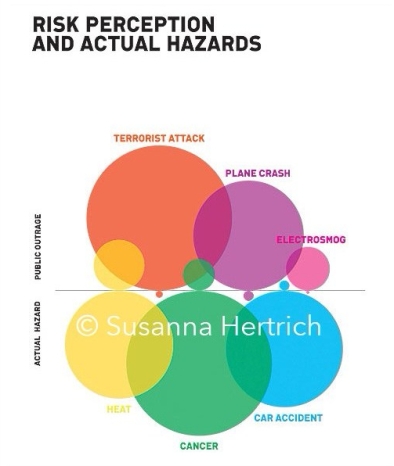This series is something neuroscientist Alison Bernstein and biologist Iida Ruishalme have been brewing over for a long time. Risk perception is such a big crux in science communication that it’s worth taking a moment to reflect on. We decided to cross-post it both on SciMoms and Thoughtscapism in the hopes of spreading the message far and wide.

Common perception of dangers vs the actual hazards they pose, by Susanna Hertrich (posted with permission).
Our decisions as parents and as consumers are exercises in balancing risks and benefits. However, risks are not always intuitive and our cognitive shortcuts can lead us astray.
Misunderstandings about risk complicate our ability to make informed decisions about everything from vaccines and medical decisions to what food we eat and feed our children. Unfortunately, humans, on the whole, are intuitively terrible at assessing risk in our own lives. Our difficulty in assigning risk seems to be innate, as discussed in this piece from Undark (Know This First: Risk Perception Is Always Irrational).
In fact, the evidence is clear that we sometimes can’t help making such mistakes. Our perceptions, of risk or anything else, are products of cognitive processes that operate outside our conscious control — running facts through the filters of our feelings and producing subjective judgments that disregard the evidence. The behavioral scientists Melissa Finucane and Paul Slovic call this the Affect Heuristic; it gives rise to what I call the risk perception gap, the dangers produced when we worry more than the evidence says we need to, or less than the evidence says we should. This is literally built in to the wiring and chemistry of the brain. Our apparent irrationality is as innate as the functioning of our DNA or our cells.
These innate tendencies result in consistent patterns in how people assess risks.
- We are bad at assigning value to long-term risks and benefits; we have an innate tendency to focus on the short-term.
- We overestimate the risk of the unfamiliar and what we don’t understand.
- Similarly, we underestimate risks of natural hazards and overestimate risks of manmade hazards.
- We often neglect to consider the risk of doing nothing or of the alternative.
- We worry more about risks that we can’t control and tend to overlook risks that we can control.
- We ignore risks we can’t see in our everyday lives.
This short video from Risk Bites is a great example of how mental shortcuts can lead us astray:
These mental shortcuts that help us get through the day do not always serve us well in our quest to make rational and informed decisions. Every choice we make in our daily lives has both risks and benefits, some more obvious than others. However, mental shortcuts and our desire for simple answers about causation, risk and benefit lead to some common errors in how we think about risk in our own lives. In this series, we will cover the following topics:
1) The difference between hazard and risk is a critical distinction.

For more about risk perception, see the introduction to this article series. On perspectives to specific risks, such as those associated with food and medicine, you can read more under Farming and GMOs and Vaccines and Health.
If you would like to have a discussion in the comments below, please take note of my Commenting policy. In a nutshell:
- Be respectful.
- Back up your claims with evidence.







Pingback: Risk In Perspective: Hazard and Risk Are Critically Different Things | Thoughtscapism
Thanks for this good article about risk, the authors make a better world with their work. What a triumph!
D.H. Neyhart
LikeLiked by 2 people
Thanks!! ❤ What a wonderful thing to hear.
LikeLike
Pingback: Risk In Perspective: Hazards Are Not All Created Equal | Thoughtscapism
Pingback: Risk In Perspective: Zero Risk Is an Impossible Dream | Thoughtscapism
Pingback: Risk In Perspective: Population Risk Does Not Equal Individual Risk | Thoughtscapism
Pingback: Measures of Toxicity | Thoughtscapism
Pingback: Do we fear the right things? | Thoughtscapism
Pingback: Toward More Intuitive Toxicology Information | Thoughtscapism
you define risk as hazard + exposure. other models as likelihood + impact. how can you compare?
LikeLike
The graphic is meant more in a conceptual nature than as a mathematical definition – it illustrates simply that to determine risk, you need to take into account both, hazard/danger and your exposure to it. For a numerical value, you’d need to estimate likelihood. Exposure of degree x would give us a certain likelihood.
I’ve seen some different exact equations, like:
Risk = failure probability x damage related to the failure
and
Risk = Vulnerability x Threat x Impact
LikeLiked by 1 person
I would say that’s the same as risk = likelihood + impact
LikeLike
Pingback: Chemical Exposures: The Good, the Bad, and the Tiny | Thoughtscapism